

Due to increased submission of material, this issue is larger than usual and includes a wide variety of articles from user interfaces to open software from EASE events to technical report details. Something for everyone!
Thank you to all Readers who returned the survey form included with the last issue; we hope to include the results in the next issue.
The EuroWorkStation (EWS) is a recently completed ESPRIT project to design and build a high power graphics workstation system to rival the large US players in the market. It consists of a powerful general-purpose workstation and a number of specialised application-specific co-processor boards connected by a fast hardware bus. The communication between the software on each processor is handled by a distributed operating system called CHORUS.
The objective of the Human Factors part of the project was to investigate a number of input devices for use in a rich interactive graphical environment for a variety of application tasks.
From the work, guidelines were developed for the selection of suitable devices and associated interaction techniques. These vary according to the user's ability, experience, and the task.
The mouse is a current standard positioning device, but only provides 2dimensional information for interaction with computers. The report, Human Factors Assessment of Input Devices for EWS, examines how a mouse can best be used in a 3-dimensional environment.
The report also describes and categorises the forms of information output as it relates to interaction. From this is developed a schema for comparing hardware input devices. A survey of existing and novel input devices was carried out. The schema explains why hand-tracking devices such as the DataGlove are useful for a more naturalistic and intuitive interaction with computers.
The DataGlove is a light-weight glove-shaped input device. The glove is made of lycra and is correspondingly light and elastic. It converts finger movement, hand position and orientation into computer-readable form in real time.
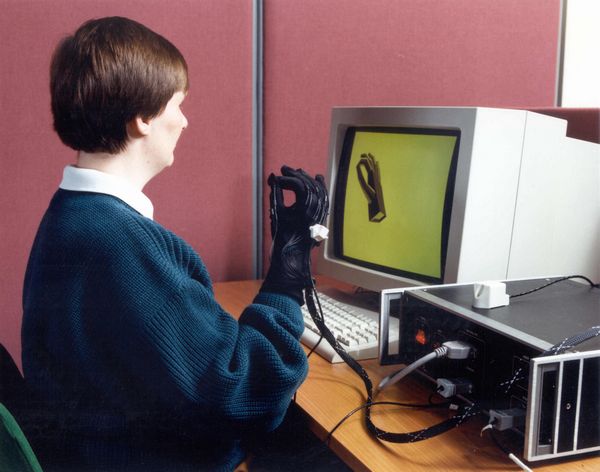
The DataGlove and mouse were compared experimentally, by getting subjects to carry out 3D tasks. The use of the DataGlove is not limited to a pure positional device, and it was further explored as a gesture input tool.
The results of an initial evaluation of a device called the Spaceball are presented. Finally the report discusses Virtual Reality and how the DataGlove could be used as a virtual tool.
Copies of the report are available from me.
Following a successful application to the Computer Board, the netlib service at the University of Kent is to be expanded to provide a national Unix-based software distribution centre. The Computer Board are funding a support person for three years while RAL will continue to support the project by allowing the equipment they provided for the pilot scheme to remain at Kent. The netlib e-mail service and tape writing facilities will continue to be available.
We are now offering an ni-ftp service to allow users a simpler way of obtaining some of the larger files from net lib. In future files larger than a.5Mb will only be accessible via ni-ftp, although all files currently supported via e-mail will remain available.
The ni-ftp database and the e-mail database overlap but are not identical. Existing small netlib files will remain as e-mail accessible only. Larger existing netlib files will be available via both access methods. New large files will be ni-ftp accessible only. This includes a directory of unix tools which is frequently updated.
All UK based users with access to the JANET network can access the netlib ni-ftp server. Unfortunately users outside the UK cannot due to the incompatible ni-ftp protocol specific to the JANET network. To transfer files, use ni-ftp <NETLIB>path-of-file from uk.ac.ukc.harrier The ni-ftp database is arranged as a tree structure. The top (root) level directory contains the file OODIRECTORY (the first two characters are zeros) which holds a recursive listing of all the accessible directories and files. This file is updated daily. Every directory contains the two files OOFILES and OOREADME. OOFILES contains the path to that directory, a date stamp and a listing of the current directory showing all the files available at that level and their last modified date. OOREADME provides more detailed information about each file such as its function, author, version number etc. A typical user making her first niftp access to netlib might take the OODIRECTORY to see all the files contained in the database. Using ni-ftp
<NETLIB>OODIRECTORY from uk.ac.ukc.harrier
After receiving this file she may decide to examine a particular directory, raltex say. Using ni-ftp with the file path
<NETLIB>unix/raltex/OOFILES from uk.ac.ukc.harrier
would give her a list of files in that directory, and
<NETLIB>unix/raltex/OOREADME from uk.ac.ukc.harrier
would give detailed information about each file in the raltex directory.
After receiving this file she may decide that tgrind.tar.Z is the file she requires. Using ni-ftp
<NETLIB>unlx/raltex/ tgrlnd.tar.Z from uk.ac.ukc.harrier
transfers the required file.
A frequent user of netlib may well know exactly which file she wants and can request that file without any preliminary information or she may request the OOFILES for that directory to see if any of the files have been updated since she last obtained them.
This system, developed at RAL, is for generating, converting, viewing and plotting Computer Graphics Metafiles (CGMs) is now available via ni-ftp using
<NETLIB>unlx/ralcgm/ralcgm.tar.Z from uk.ac.ukc.harrier
as well as via e-mail (to netlib@ukc.ac.uk)
send encoded.tar from ralcgm
and tar format cartridge tape, send a tape to Tim Hopkins, Computing Laboratory, University of Kent, Canterbury.
The contents of the UMIST TEX archive are also available via ni-ftp. The files available include
A full description of all the files available may be obtained using
<NETLIB>unlx/raltex/ OOREADME from uk.ac.ukc.harrier
Also available are two graphical tools developed at the University of Kent
Other software available via ni-ftp includes f2c (the AT&T Fortran to C converter), complete libraries for linpack. eispack and fftpack and the larger TOMS routines.
Netlib's execution facilities have been extended to include the Fortran 77 source formatter from Toolpack, istlp. To execute istlp with your own Fortran-77 source code send the following message to netlib@ukc.ac.uk
execute istlp
and immediately follow it with your data for istlp. The reformatted source will be sent via e-mail. (Note that the tool expects ANSI standard conforming Fortran 77.) For example, a complete mail message might be
execute istlp program test 10 a=1 43 j=2 78 k=3 goto 10 goto 43 goto 78 end
More information about istip is available. Mail netiib@ukc.ac.uk with
send index for exec/execlstlp
A full list of the available libraries may be obtained by sending a mail message to netlib@uk.ac.ukc whose body contains the single line
send index
The file containing details of new and updated software can be retrieved via the message
send updates from updates
If you would like to see particular pieces of software made available or have suggestions to improve the service then e-mail your suggestions.
This course is an extension of the one developed under the EEC COMETT Programme. It is designed to give an introduction to human factors issues in the design of the user interface. The course is being run by the Human Computer Interaction Section of the SERC Rutherford Appleton Laboratory.
The course is aimed primarily at Computer Scientists who wish to learn more about human factors in the design of user interfaces to computer systems. A degree of familiarity with computers is therefore necessary. The course will use 8 high-performance workstations (SUNs) so that each person attending has access to a machine throughout the course. Emphasis will be placed upon hands on use of the machine and upon individual experimentation, although prior familiarity with this equipment is not required.
Ben Shneiderman (1987), Designing the User Interface Addison-Wesley ISBN 0-201-16505-8.
Ronald M Baecker and William A S Buxton (1987), Readings in Human-Computer Interaction, Morgan Kaufmann, ISBN 0-934613-24-9.
The course will consist of about six hours of tuition per day. There will be three classes of presentation:
A set of course notes (based upon the overhead transparencies used and with additional material) will be provided for each person attending.
The Universities Funding Council's new Information Systems Committee (ISC) has launched an initiative to encourage and accelerate further developments in the training for use of IT throughout UK universities. £3m has been allocated to support this initiative over a three year period commencing 1 August 1991 The aims of the Initiative are:
A National Coordinator, Brian Shields, based at the University of St Andrews, has been appointed to oversee the work of the initiative. ISC received a total of 91 applications and the Initiative's Steering Group has agreed to support 24 projects.
The products of the projects will cover the following training strands which are required to satisfy the objectives of the Initiative.
To equip universities with materials to help train potential users of current application services which are applicable to a wide spectrum of users or for which national financial support has been received.
To equip Computer Centres and their users with the required level of knowledge and application of the future cornerstones of centrally managed computing services. These cornerstones are:- Networks, Unix, Windows and Distributed Computing Services.
This area is adequately covered by a number of projects. The Coordinator, in conjunction with the Committee of Vice Chancellors and Principals (CVCP) Staff Development Unit, intend to provide a form of direction towards establishing a measure of concensus on the IT competency levels required of university staff and towards ensuring that the projects contribute much of the material required to train staff to the appropriate level.
This area is the one in which the majority of developmental projects are to be found (although often this is combined with other areas such as basic IT skills and Unix) and where the issues relating to computer-based training in specific subject disciplines are addressed. Whilst there is a necessary research and development content, these projects will contribute considerably towards producing the new materials for Strand 3. They will identify the appropriate level of training requirement for Academic Staff in Authoring skills and recommend the appropriate standards of use. This area is viewed by many as the most relevant application of IT to help universities meet their future teaching challenges.
One project is aimed at improving the competence of Computing Advisory Staff in the areas of human communications, problem solving and instruction and another project will set up an IT training unit jointly with commercial training providers.
A number of other staff development areas will be addressed by the CVCP Staff Development and Training Unit in conjunction with the Coordinator throughout the duration of the Initiative.
Plans are to be put in place to hold up to two regional seminars per year at each UK Region to which University Staff Development Officers and Computer Centre Training Staff will be invited. The aims of these seminars are to help ensure that the products of the Initiative have a successful impact on universities and to ensure that those involved in the Initiative projects can position their work within the overall staff development and IT Training activities of the university community. If there is sufficient interest, Directors of the Computer Teaching Initiative Centres will also be invited.
Already there are identifiable products for consideration for bulk purchase. There is every prospect that the numerous evaluation exercises being undertaken will also indicate useful training products for further consideration. The Initiative has reserved some funding for this purpose and will, additionally, recommend the national purchase of some software items to CHEST . The project topics and sites are listed above. The project outlines can be found under the NISSBB Sections in the H7B group. For further information please contact me.
UMIST and RAL recently completed the second phase of the EASE-funded User Interface Management Systems (UIMS) assessment exercise.
The objectives were to provide detailed insight into currently available commercial UIMS from a programmer's point of view and if possible to recommend a suitable product as part of the EASE interface development software tool.
The project's timescale necessitated us to shortlist five products from a proliferation of available UIMS or UIMS-like products. We restricted our evaluations to only those products that are available for a wide range of hardware platforms, have strong supplier support and are compatible with the X Window System TM to ensure portability and adaptability to emerging de facto standards in windowing environments. The products selected were devGUIDE from Sun Microsystems, Open Dialogue from Hewlett-Packard, Graphical Modelling System (GMS) from Sherrill-Lubinski Corporation, USEIT from UNIRAS and TeleUSE from TeleLOGIC. All of the five systems provide a high level support for interface development.
The assessment aimed to determine the utility of the systems for building the user interfaces of engineering applications, in particular in the effort involved in reproducing the interaction style of an existing FORTRAN based application. The benchmark application used an interaction style common to most, if not all, engineering applications.
Some of the other important aspects considered were:
Some of the important evaluation results are:
The complete assessment on each system provides useful information for application developers who wish to utilise any of these systems to build their application.
This document is now available as a EASE Technical Report.
The Open Software Foundation (OSF) celebrated its third birthday on 17 May 1991. In this note, we examine some of the accomplishments of these first three years and outline the research programme which will contribute to the future offerings.
The OSF has established the Request For Technology (RFI) process as its open process to solicit inputs and technology. RFT requirements are defined in a process which involves consultation of OSF members (via SIGs and member meetings), after which any organisation can respond with relevant technology; external consultants fonn part of the review team, to guarantee neutrality; after selection, a rationale is published, which guarantees the impartiality of the process.
OSF's first two offerings, OSF/Motif and OSF/l, have demonstrated clearly OSF's commitment to standards: OSF/Motif is based on, and conforms strictly to, the X11 de facto standard, while OSF/1 conforms to Posix 1003.1, XPG3 base, SVID V2 (except where there are incompatibilities between these standards).
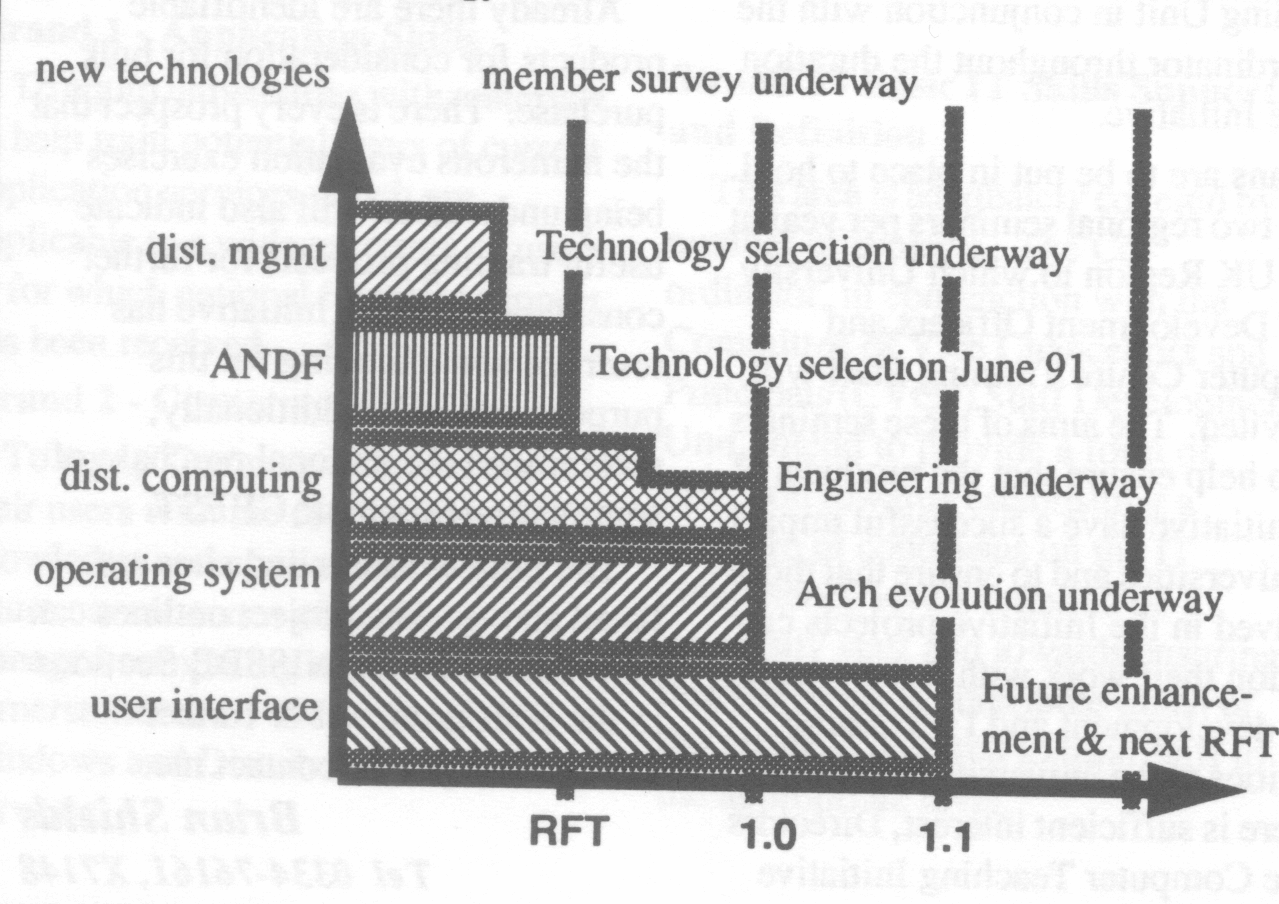
In figure 1 we illustrate the status of the different technologies which have been the subject of OSF RFTs to date. In the following sections we provide more details of these technologies and the plans for their evolution.
OSF/Motif was the first technology brought to market by OSF. Its essential contribution was to marry the network capabilities of X-Windows with a PC Look-and-Feel. It did so by providing a library of parts, and a window manager with similar behaviour to Presentation Manager.
Motif 1.1 is now available; this release is compatible with X11R4, and incorporates many new features for faster application development and increased usability. It also includes UIL technology enhancements (WML language features and support for new widget addition) enhanced international language support, enhanced colour generation and shared library support.
The design of OSF/1 sought to satisfy two requirements:
In order to satisfy the second requirement, OSF/1 was architectured around the Mach kernel, which provides a path to microkernel technology, which will be explored in the final section of this article.
The underlying concept of Mach is to provide the basic services necessary to an operating system (Unix or otherwise) using state of the art operating system technology. These core services include: scheduling; virtual memory services and physical memory management; Mach Interprocess Communication (IPC), which is the basis for user/kernel and many intra-kernel requests (note that virtual memory management and IPC are closely related in Mach). These services are provided using a small number of basic kernel abstractions:
Apart from the basic re-architecturing of the kernel, OSF/1 also offers:
The OSF DCE provides, for the first time, a framework: for the development, use and maintenance of distributed applications. The architecture of the DCE is illustrated in Figure 2, and integrates a set of eight technologies.
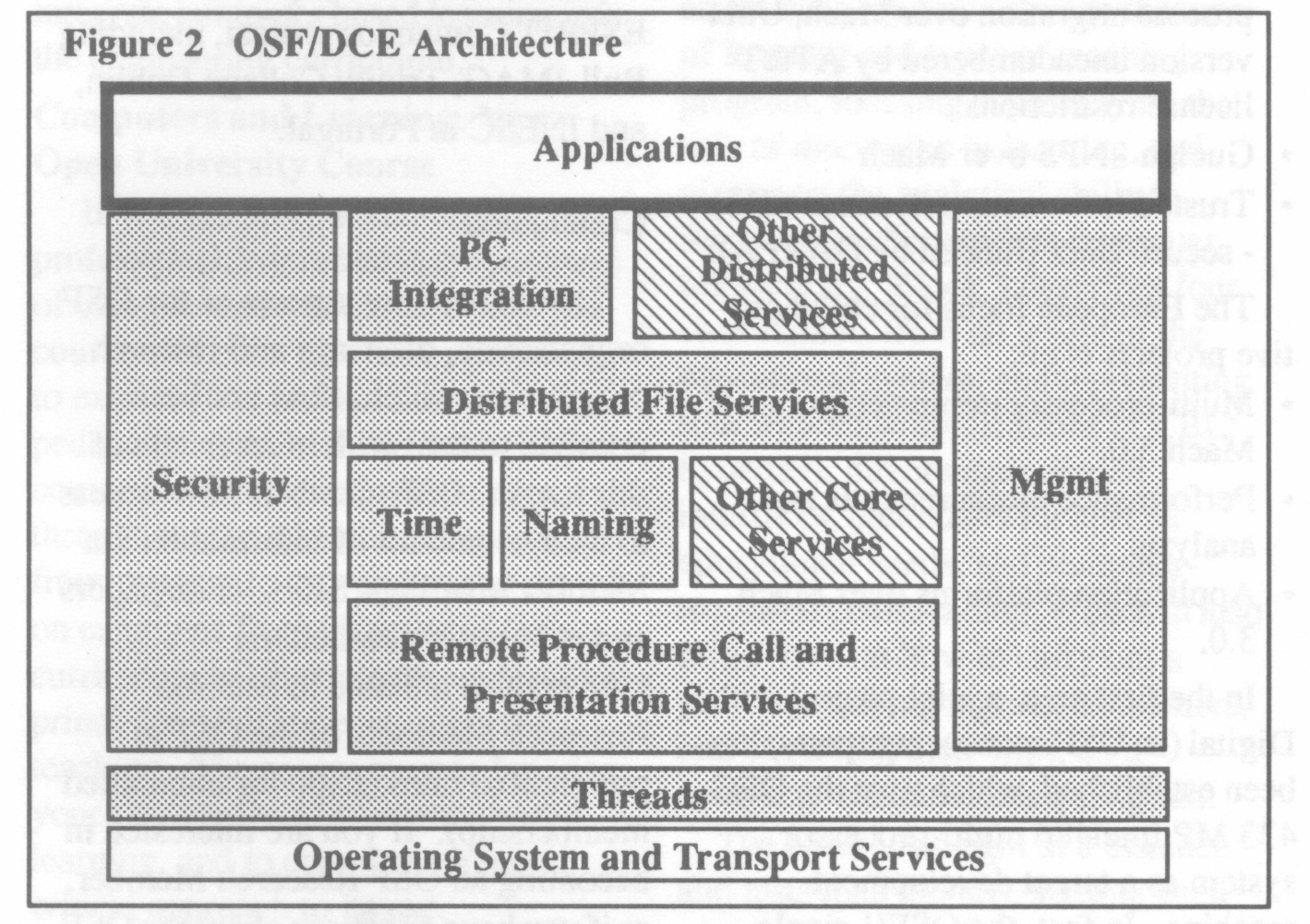
At the core of these services is the Remote Procedure Call (RPC) capability, which is the basis for building client/server applications.
The OSF DCE also provides an RPC Interface Definition Language, together with a compiler, which simplifies the development of distributed applications.
The Distributed Directory Services integrates a global naming scheme, offering full X.500 functionality, and a fast replicated local naming system.
The time service provides fault-tolerant clock synchronisation for both LANs and WANs, which is needed for scheduling and event sequencing of distributed applications.
The threads service allows programmers to exploit multiprocessor support when this is available, and provides transparent emulation otherwise, to allow concurrent programming.
The OSF DCE is completed by:
The Application Neutral Distribution Format (ANDF) provides a distribution format for multiple architectures. ANDF is similar to an intermediate compiler format in that an ANDF Producer takes source code and produces an ANDF file. ANDF Installers are required for each different hardware architecture, in order to install an executable on a particular hardware platform.
The OSF announced on June 4 1991 that it has selected the TDF technology from the Electronics Division of the Defense Research Agency of the UK (formerly Royal Signals and Radar Establishment) for the core technology of ANDF. A two-year programme for its introduction has been defined. The latter includes the definition of an Application Program Interface, which is critical to the success of the ANDF.
The OSF DME addresses the problem of management of systems interconnected in a multi-vendor computing environment. The solution of this problem is considered to be crucial if open systems are to gain widespread acceptance for commercial use.
The RFT for the OSF DME defined the scope of the RFT to include both a management framework:, and management applications for both system and network management. Standards conformance, portability and validation and testing support were among the mandatory requirements for responses to the RFT.
A DME selection announcement is scheduled for the second half of 1991.
In this final section, we describe the role of the OSF Research Institute (RI), and the advanced development programme. The OSF RI, has centres in Cambridge Mass. and Grenoble France, has assured technical innovation by both its in-house advanced development programme, and a number of collaborative projects, which will be described below.
The activities of the OSF RI fall under three main categories:
These activities are intimately related, and for example one major goal of the Research Relations activity, in addition to informing the research community about what we are doing, is to set up collaborative projects which complement the advanced development programme.
The current focus of the advanced development programme is the evolution of the operating system architecture. Figure 3 illustrates how the current approach is to move towards a multi-server architecture in two stages:
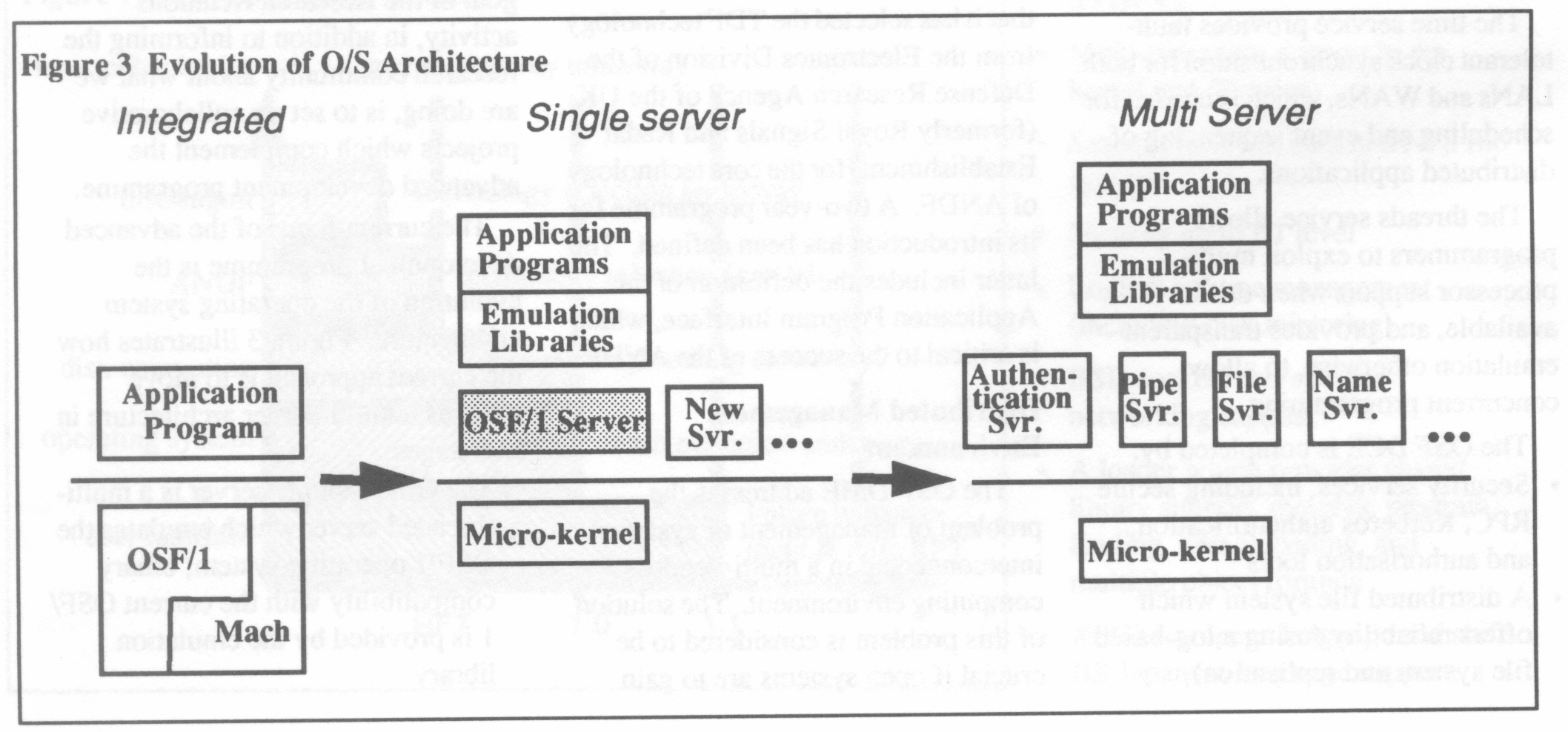
The current status of the OSF RI programme is that the development of an OSF/l single server over the Mach microkernel, which is being done at the Grenoble RI, is well advanced, and a prototype version should be available later this year. Particular attention has been paid to the methodology employed, and one by-product of the development is a framework which can be used for the development of single servers which emulate other flavours of Unix.
One critical question concerning the microkernel architecture is that of performance; there is of course some overhead associated with the Mach message passing and, although there are strong reasons to believe that other Mach mechanisms (lazy evaluation, etc.) will compensate for this, performance measurements and analysis are an important adjunct to the single server development.
In addition to the single server development, the following areas are also being investigated by the OSF RI:
The US and European centres have sought to collaborate with research groups in their respective catchment areas.
For the Cambridge RI, the principle active collaborations are:
The European focus for collaborative projects is on:
In the first area, a joint project with Digital (an OSF sponsor company) has been established, which uses the DEC 433 MP Intel486 multi-processor system as a target development machine. In fact, the OSF/1 single server development will be targeted at this machine.
A collaboration agreement with GMD is aimed at using performance analysis tools developed by the GMD RelaX project to probe the microkernel based single server system.
Finally, application platforms which use novel technology are seen as a means of testing the validity of the microkernel approach, which is more probing than using standard Unix applications. In particular, distributed object management platforms, which have a requirement for creating large numbers of memory objects of varying size, can potentially exploit the Mach mechanisms directly to enhance performance. This aspect is being explored with several partners of the ESPRIT Comandos project, including Bull-IMAG, Trinity College Dublin, and INESC in Portugal.
There are many aspects of the OSF organisation, offerings and research programme which it has not been possible to deal with in an article of this length. OSF members have access to a large amount of information via Member Meetings, SIGs, white papers and electronic newsletters. Universities are able to become Research Members of the OSF at preferential rates (£200 for unbundled membership). If you are interested in becoming an OSF Research Member, or if you have questions about the OSF RI activities, please contact me.
The CTI (Computer Teaching Initiative) Centre for Engineering exists to promote the uptake of computers in teaching engineering to undergraduates. The Centre has distributed information about software for this purpose and would now bring to your attention a course at the Open University which will assist you to integrate computer based learning into the engineering curriculum.
If you are an educational professional, interested in the potential of using computers for teaching, this course will offer you the opportunity to extend your analytical and pedagogical skills in the field. The course covers uses of computers throughout the educational spectrum from primary to university, and draws on examples from all areas of the curriculum to illustrate the underlying principles of using computers for teaching. The course aims to broaden your knowledge of computer-based learning, and to encourage a more critical approach to its use.
The material is taught in three Blocks. Block 1 covers integration of generic programs with existing curricula, a taxonomy of types of computer- based learning (CBL) tutorial, simulation, computer conferencing etc - a framework for critiquing existing software, evaluation techniques, gender issues, the role of government in the use of computers in teaching. Block 2 establishes the link between theories of learning and types of teaching program, focusing especially on the role of discussion in learning, and gives you the analytical skills to interpret teacher-student-computer interactions. Block 3 describes four case studies, from all levels of the educational system, and representing four important applications of CBL: hypertext, direct manipulation interfaces, computers for special educational needs, and computer-mediated conferencing. You will also be advised on how to carry out a project, studying a group of learners, and observing their work on a computer-based teaching program.
The course is taught at a distance and lasts nine months, starting each year in February. You would need to spend approximately 5-6 hours per week to keep up with the work, including course assignments and project work. Every registered student is assigned a tutor, who will mark and comment on assignments and project report, provide help over the telephone, and arrange tutorials should you wish to attend.
Computers and Learning provides a flexible, yet structured approach to learning, using text, audio, video, computer- based learning and practical work. You will need access to an IBM-PC compatible, with MS-DOS, but all course software is provided. It will also be necessary to have access to a small group of students for the practical work.
We would like to thank all those who took time to fill in the information form we provided with the announcement of Rutherford Appleton Laboratory's (RAL's) intention to set up a Visualisation Community Club (ECN33,July 1991).
The replies came from researchers, developers, current and prospective users of visualisation, and enabled us to gain a better idea of the state of visualisation in the Engineering Applications Support Environment (EASE) community.
A discussion of the results of this request for information will be one of the items on the agenda of the first meeting of the Visualisation Community Club, which will take place on Friday, 11 October 1991 at RAL. Other topics will include a report from the recent Visualisation Workshop, presentations of visualisation work in the EASE community, discussion of the aims and plans of the Club and so on.
We will be sending the full programme and registration form for this first meeting direct to all those who have registered with the Community Club. If you are interested in attending the meeting but have not yet returned the information form, please do so by Monday 23 September 1991 or contact the author.
We look forward to seeing you at the meeting.
David Lomas left UMIST on 1 May 1991 to become Computer User Services Coordinator in the Academic Information Services Department, University of Salford.
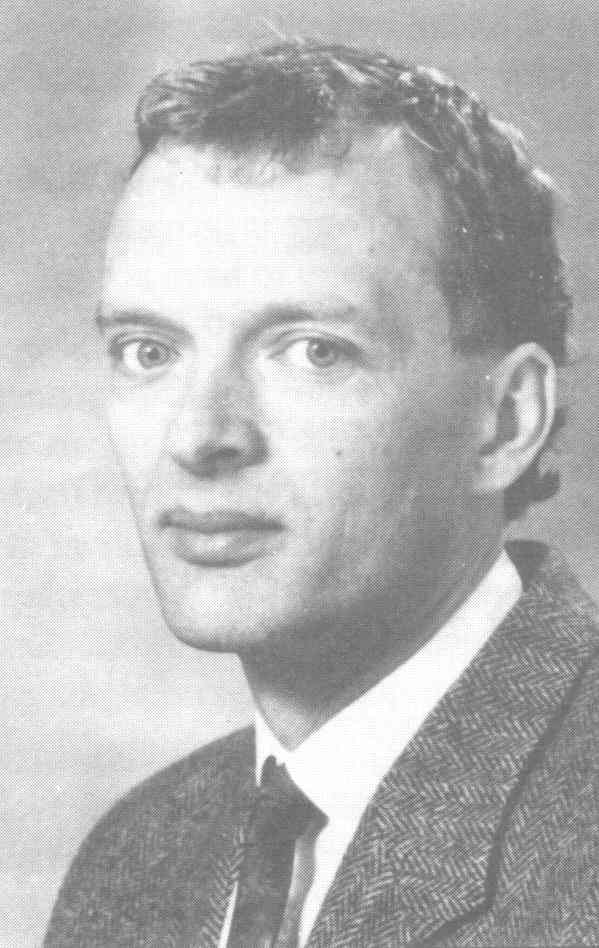
David has been associated with both the Interactive Computing Facility (ICF) and the EASE Programme for more than eight years. He was employed on an Rutherford Appleton Laboratory (RAL) contract, let with UMIST, to provide support initially for users of the ICF and, more recently, for the EASE Programme.
David's personality and qualities made him an ideal person for the roles he has carried out on RAL's behalf. Little surprise therefore that he has been snapped up by Salford!
We all wish him every success in his new job.
Geoff Lambert left Informatics Department on 1 April 1991 to join Technology Department at RAL, where he is involved in Marketing within Electronics Division and Rutherford Research Services Coordination.
Geoff joined the ICF team at RAL on 1 April 1981 after several years as Operations Manager of the RAL IBM mainframe installation. Since that time he has given sterling service over the decade to the UK Engineering academic community. Recently, under the EASE Programme, Geoff was responsible for this newsletter and the Education and Awareness Programme.
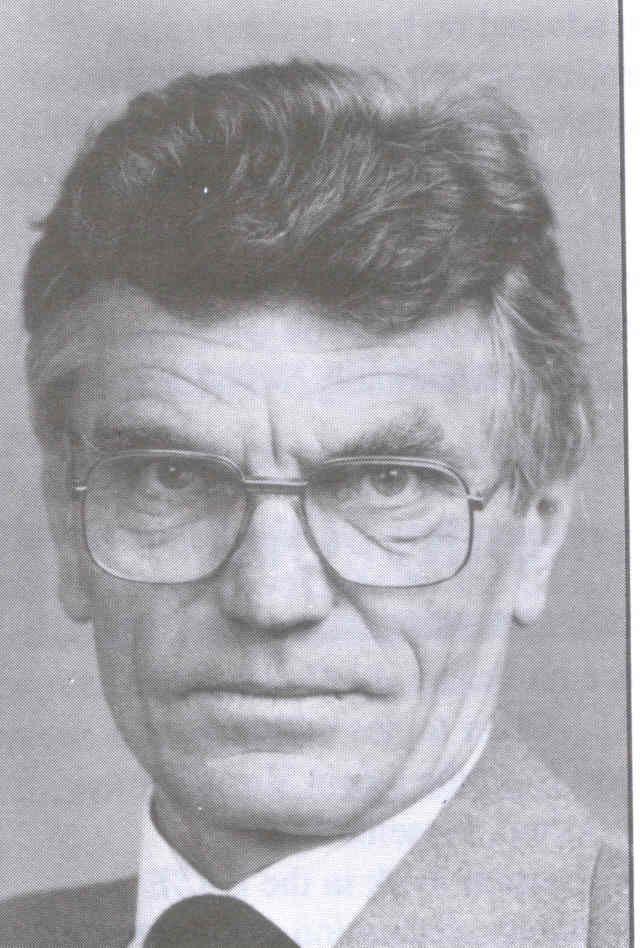
His new job entails close interactions with the UK Micro-Electronics community and no doubt he will look up his ICF and EASE colleagues on his travels around the UK. (Yes, he is still clocking up the miles - and the claims!!)
On a personal note Geoff and I have worked together ever since he joined the ICF and I have enjoyed our involvement both as a work colleague and a friend. I am sure you will all join me in wishing Geoff every success in his new job.
Debbie took over as Head of the Education and Awareness Group in Informatics Department at RAL on 1 April 1991. She is a Chartered Mechanical Engineer who joined the Laboratory in 1984 from Lucas.
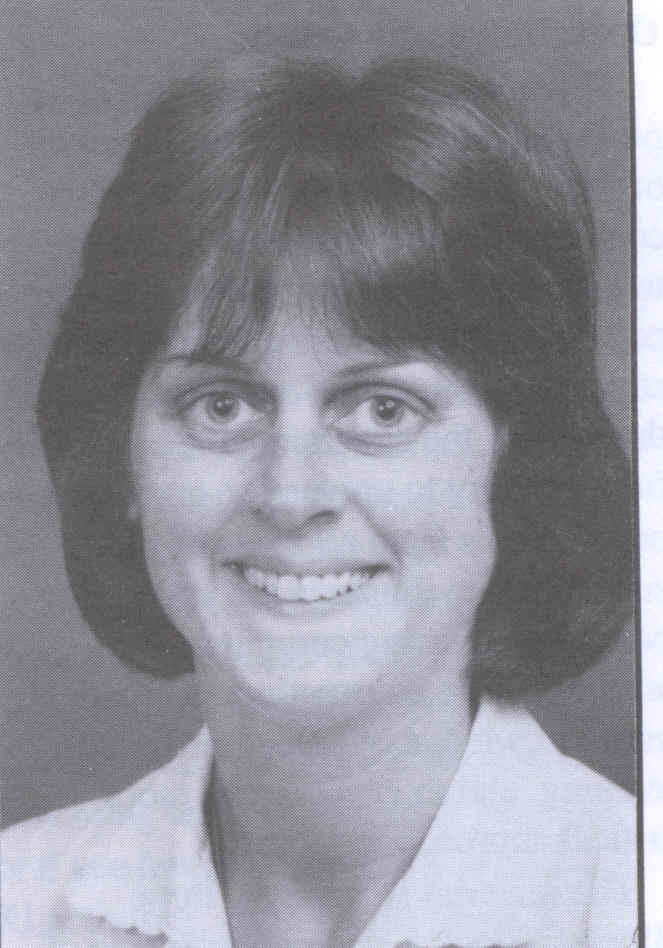
Her first six years here were spent working in the area of Finite Element Data Exchange, being involved in the Esprit CAD* I and ISO STEP Projects. She moved to Informatics Department with the rest of the Applications Programming Group in 1987 and has been closely involved with the EASE Programme since it started.
She recently moved to part-time working following the birth of her first child. Her influence on the Education and Awareness Programme is already paying dividends. We can all look forward to a highly beneficial future for these activities under Debbie's expert guidance.
As the SERC funding for the AI Support for Engineers project comes to an end at the end of September, this will be our last official article for the Engineering Computing Newsletter. The project itself has been running for five years. During this time we have provided a lot of advice, at both the individual level and through workshops and courses, on a range of topics such as building AI systems and selecting tools. Our tool evaluation reports have been seen as particularly useful to the engineering community. We anticipate that our training and awareness programme will continue in the form of short courses and workshops but less emphasis will be placed on engineering-related issues and more attention given to the wider applicability of artificial intelligence tools and techniques.
We hope that, despite the lack of SERC subsidy, the academic engineering community will continue to attend our training courses and seminars and that we will have continuing contact with the many friends we have made throughout the duration of this project.
A list of the reports produced during the course of the project, and which are available free of charge to SERC-supported academic engineers, can be obtained from Terri Lydiard.
This SERC-sponsored project providing awareness to the academic engineering community on all issues concerning artificial intelligence comes to an end in September 1991. As a result the training places at reduced fees for academic engineers working on SERC funded projects will no longer be available. However standby places are available for all academics. The standby academic fee is 40% of the standard course fee. Standby places maybe booked at any time but registration can only be confirmed one week before the start of the course and will depend on the number of standard registrations.
EASE Education and Awareness Seminar, organised by the Artificial Intelligence Applications Institute at the University of Edinburgh 9 September 1991, Committee Room G09, IEE, Savoy Place, London WC2
Two new EASE Technical Reports are now available: